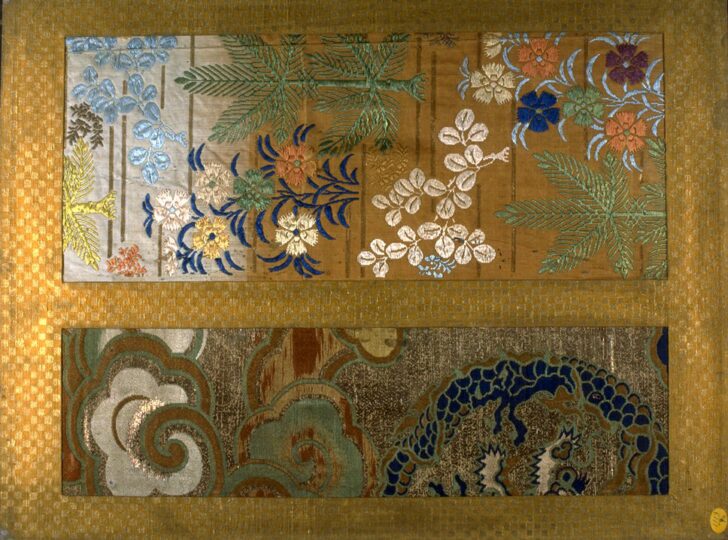One of Four Panels of Textile Fragments: Kinran and Karaori
Japanese

Description
Panel of textile fragments: kinran and karaori
Japan, early Edo Period (1615–1868)
17th–18th century
Left: Silk brocade with gilt paper (kinran)
Right: Silk brocade woven using the karaori technique
Transfer from the College of Architecture and Design, 1972/2.44.1
The textile to the left, possibly part of an obi (sash for kimono) is adorned with a design of a dragon cavorting among clouds, a perennially favorite motif. This stiff and heavy fabric makes use of kinran, one of many techniques for incorporating precious metals into fabric: narrow strips of paper coated with gold leaf are actually woven into the fabric as wefts. Since the gold leaf can be extremely thin, kinran is a less extravagant process than applying foil-wrapped threads to the surface of the cloth.
The fabric to the right was once part of a garment worn by an actor playing a female role in traditional Noh drama. With its cool color scheme and autumnal plants (pine, bush clover, and pinks), it evokes a melancholy mood. The weaving technique seen here is known as karaori, meaning “Chinese weave,” as it was originally developed in China. The warp threads are made from raw silk that has been tie-dyed in alternating large blocks of pale blue and brown. The plants are formed by long floating weft threads of degummed silk.
Subject Matter:
The textile to the left, is possibly part of an obi (sash for kimono) and decorated with kinran, one of many techniques for incorporating precious metals like gold into fabric.
The fabric to the right was once part of a garment worn by an actor playing a female role in traditional Noh drama. With its cool color scheme and autumnal plants (pine, bush clover, and pinks), it evokes a melancholy mood. The weaving technique seen here is known as karaori, meaning “Chinese weave,” as it was originally developed in China.
Physical Description:
This brocade makes use of gold thread, creating a composite that shimmers. the warm, muted tones of the gold are matched in color selections of light blue, dark blue, yellow, mauve, silvery white, and muted green threads. Two textile fragments have been sewn into a gold background. On the left is a rectangular segment of a blue and green dragon among clouds. The right segment is a floral decoration of a variety of plants and colors, interspersed with horizontal lines.
Usage Rights:
If you are interested in using an image for a publication, please visit https://umma.umich.edu/request-image/ for more information and to fill out the online Image Rights and Reproductions Request Form.